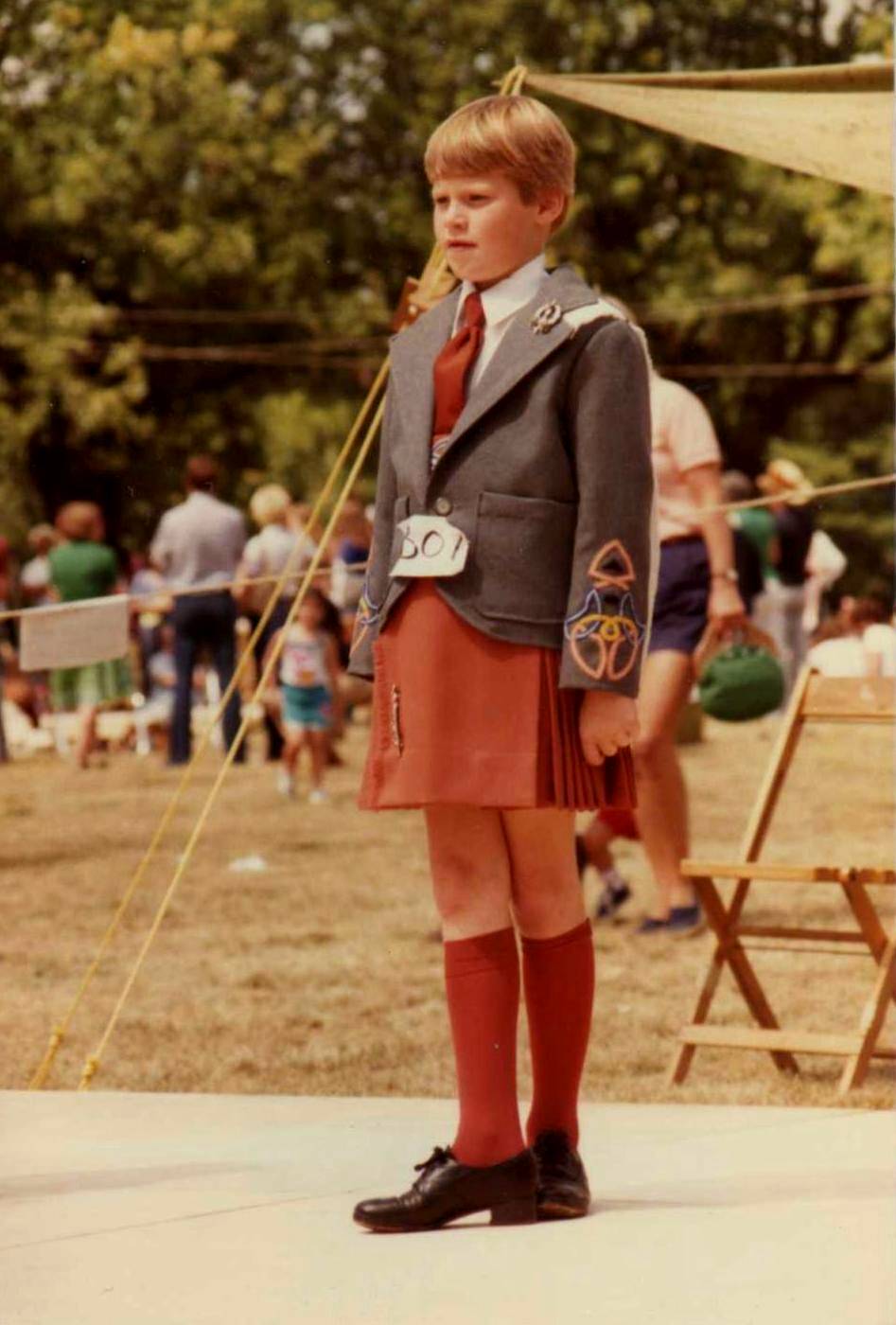
Irish Step Dancing Costumes: Colors

Figure 1.--Here we see an Irush step dancer boy in an grey and orange performance costume. Notice the embroidery in the sleeves abd the matching orange knee socks as well as the tie. Colorful costumes like this seemed popular with the younger boys and their moms.
|
|
Color is a major element of the Irish step dancing costumes. The costumes worn by the dancers have changed dramatically over the centuries and this has included the color. The formation of the Gaelic League began to set standards for Irish dancing (1893). The standard costume for women abnd girls becanme a white dress with a sash, and a green hooded shawl or cloak worn over the top. Gradually the cloak isappeared, but the shawl remained and developed into the stylised shawl of modern dresses. The sash persisted as a cord tied around the waist. This can still be seen in some school costumes. After World War I we begin to see more color. Dresses began to be done in
green, saffron, or white (1920s). These are of ciourse the colors of the Irish flag. Red was not common as there was an association with the British Red Coats which had occupied Ireland. This is when we begin to see boys dancing in kilts. We are not sure about the color of the early kilts. We suspect that they were similar to the colors for the girls' dresses. green, safron, and white. These were commonly the colors chosen by dancuing schools for the school costumes that the younger dancers wear.
We are not sure when boys began to wear a greater variety of colors. After World War II in the 1960s we beggin to see boys wearing a wide range of colors including many bright colors. We have seen just about every color used for these costumes, including black, blue, briwn, green, grey, orange, purple, red, white, and yellow, Anout the only color we have not seen is pink. Usually the bright colors were used for the kilts and a neutral color like blue or grey used for the blazer-jacket. But we have seen some bright colors used for the jackets as well In these cases a subdued color was just for the kilt. The costumes are always done in contrasting colors for the kilts abd jackets. Often knee socks and ties were chosen in the same color as the kilts or in some cases the jacket. The boys costumes were much more colorful than the girls' costumes. We note dress makers advising girls to select a color that suits their coloration and body stature. For the boys it just seems to be a fun matter that the boys and their mothers like. The younger boys had the most colorful costumes. Older boys more commonly wore darker color, more neutral colors. Since the advent of Riverdance, color has been much less of a factor. Kilts have become less common. And the long pants the boys wear without jackets are never done in bright cilors. They are almost always navy blue or black.
HBC

Navigate the Historic Boys' Clothing Web Site:
[Introduction]
[Activities]
[Biographies]
[Chronologies]
[Countries]
[Style Index]
[Bibliographies]
[Contributions]
[Frequently Asked Questions]
[Bibliographies]
[Images]
[Links]
[Registration]
[Tools]
[Boys' Clothing Home]
Navigate the Historic Boys' Clothing Web chronological pages:
[The 1880s]
[The 1890s]
[The 1900s]
[The 1910s]
[The 1920s]
[The 1930s]
[The 1940s]
[The 1950s]
[The 1960s]
[The 1970s]
[The 1980s]
[The 1990s]
Navigate the Historic Boys' Clothing Web dance pages:
[Main dance page]
[Ballet]
[Irish step]
[Highland]
[Ballroom]
[Native American]
[Tap]
Navigate the Boys' Historical Clothing kilt pages:
[Main kilt page]
[Kilt suits]
[Scottish kilts]
[Scottish boys clothing]
[Scottish school uniform]
[Highland dance]
[Irish kilts]
[Irish boys clothing]
[Greek kilts]
Created: 6:41 AM 7/5/2013
Last updated: 6:41 AM 7/5/2013



